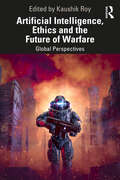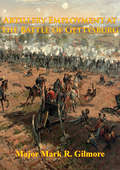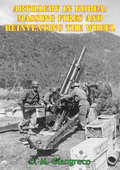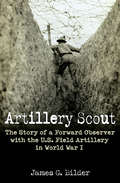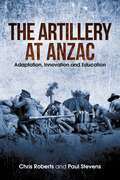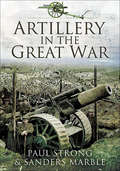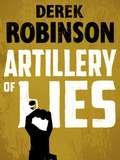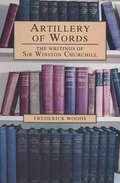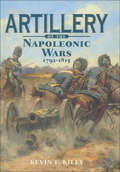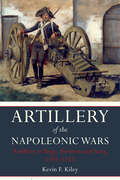- Table View
- List View
Artificial Intelligence, Ethics and the Future of Warfare: Global Perspectives
by Kaushik RoyThis volume examines how the adoption of AI technologies is likely to impact strategic and operational planning, and the possible future tactical scenarios for conventional, unconventional, cyber, space and nuclear force structures. In addition to developments in the USA, Britain, Russia and China, the volume also explores how different Asian and European countries are actively integrating AI into their military readiness. It studies the effect of AI and related technologies in training regimens and command structures. The book also covers the ethical and legal aspects of AI augmented warfare.The volume will be of great interest to scholars, students and researchers of military and strategic studies, defence studies, artificial intelligence and ethics.
Artillery Employment At The Battle Of Gettysburg [Illustrated Edition]
by Major Mark R. GilmoreIncludes Civil War Map and Illustrations Pack - 224 battle plans, campaign maps and detailed analyses of actions spanning the entire period of hostilities.This book is an historical analysis of the Union artillery at the Battle of Gettysburg. It examines the significance of the Union artillery's contribution to the Federal victory. This study explores all aspects of the tactical employment of the Union artillery on the first and last days of the battle. A brief description of the evolution of artillery organization in the Army of the Potomac prior to the battle of Gettysburg is included. This is followed by the chronological presentation of the tactical employment of artillery during the battle. First its employment in the meeting engagement on 1 July is examined, followed by a study of its use on the final and decisive third day when Union forces fought a set-piece defensive battle. Among the conclusions arrived at during the course of this study are these: that the Army of the Potomac's corps artillery brigades and army artillery reserve proved to be responsive and efficient organizations in fulfilling their fire support mission, and when coupled with the skillful use of artillery and aggressive leadership by the army's Chief-of-Artillery, Brigadier-General Hunt, were crucial to the successful employment of the Union artillery forces. This study concludes that the Union artillery under the command of Brigadier General Henry Hunt had a decided and positive influence on the Federal victory by successfully employing its corps artillery brigades and army artillery reserve as part of a combined arms force.
Artillery In Korea: Massing Fires And Reinventing The Wheel [Illustrated Edition]
by D. M. Giangreco[Includes 10 photos illustrations]The first 9 months of the Korean War saw U.S. Army field artillery units destroy or abandon their own guns on nearly a dozen occasions. North Korean and Chinese forces infiltrated thinly held American lines to ambush units on the move or assault battery positions from the flanks or rear with, all too often, the same disastrous results. Trained to fight a linear war in Europe against conventional Soviet forces, field artillery units were unprepared for combat in Korea, which called for all-around defense of mutually supporting battery positions, and high-angle fire. Ironically, these same lessons had been learned the hard way during recent fighting against the Japanese in a 1944 action on Saipan, not Korea, aptly demonstrates. Pacific theater artillery tactics were discarded as an aberration after War World II, but Red Legs soon found that they "frequently [have] to fight as doughboys" and "must be able to handle the situation themselves if their gun positions are attacked." A second problem with artillery in Korea was felt most keenly by the soldiers that the artillery was supposed to support -- the infantry. Commanders at all levels had come to expect that in any future war, they would conduct operations with fire that equaled or even surpassed the lavish support they had recently enjoyed in northwest Europe. It was clear almost from the beginning, however, that this was not going to happen in Korea because there was a shortage not only of artillery units but also of the basic hardware of the cannoneers craft: guns and munitions. Until the front settled down into a war of attrition in the fall of 1951 (which facilitated the surveying of reference points and positioning of "an elaborate grid of batteries, fire direction centers, [and] fire support coordination centers"), massed fires were achieved by shooting at unprecedented speed.
Artillery Scout: The Story of a Forward Observer with the U.S. Field Artillery in World War I
by James G. Bilder“Moves quickly; it entertains and provides a decent overview of the life of an American Doughboy” on the Western Front during the Great War (San Francisco Book Review).The American Doughboys of World War I are often referred to as the “Lost Generation”; however, in this book, we are able to gain an intimate look at their experiences after being thrust into the center of Europe’s “Great War” and enduring some of the most grueling battles in US history.Len Fairfield, the author’s grandfather, was an Artillery Scout, or Forward Observer, for the US Army and was a firsthand witness to the war’s carnage as he endured its countless hardships, all of which are revealed here in vivid detail. His story takes the reader from a hard life in Chicago, through conscription, rigorous training in America and France, and finally to the battles which have become synonymous with the US effort in France—St. Mihiel and the Argonne Forest, the latter claiming 26,000 American lives, more than any other US battle.The American Expeditionary Forces endured a rare close-quarters visit to hell until it was sensed that the Germans were finally giving way, though fighting tooth-and-nail up to the very minute of the Armistice. This action-filled work brings the reader straight to the center of America’s costly battles in World War I, reminding us once again how great-power status often has to be earned with blood on battlefields.“All in all, this book is a bit of a gem. It is a well paced easy read and you will find yourself rooting for our hero.” —War in History
Artillery Warfare, 1939–1945
by Simon Forty Jonathan Forty“From mountain warfare with guns on mules to V2 rockets and everything between makes it well worth a place on anyone’s reference shelf.” —Clash of SteelIt is said that artillery won the Second World War for the Allies—that Soviet guns wore down German forces on the Eastern Front, negating their superior tactics and fighting ability, and that the accuracy and intensity of the British and American artillery was a major reason for the success of Allied forces in North Africa from El Alamein, in Italy and Normandy, and played a vital role in the battles of 1944 and 1945. Yet the range of weapons used is often overlooked or taken for granted—which is why this highly illustrated history by Simon and Jonathan Forty is of such value. They stress the importance of artillery on every front and analyze how artillery equipment, training and tactical techniques developed during the conflict.The selection of wartime photographs—many from east European sources—and the extensive quotations from contemporary documents give a graphic impression of how the guns were used on all sides. The photographs emphasize the wide range of pieces employed as field, antiaircraft and antitank artillery without forgetting self-propelled guns, coastal and other heavyweights and the development of rockets. The authors offer a fascinating insight into the weapons that served in the artillery over seventy years ago.“Superbly illustrated, this is testament to the courage and skills of extraordinary men in the execution of their duty. An amazing book.” —Books Monthly
Artillery at Anzac: Adaptation, Innovation and Education
by Chris Roberts Paul StevensA Simon & Schuster eBook. Simon & Schuster has a great book for every reader.
Artillery in the Great War
by Paul Strong Sanders MarbleA year-by-year examination of key WWI battles and how the ongoing advances in artillery shaped strategy, tactics, and oprations; includes battlefield maps! World War I is often said to have been an artillery war, yet the decisive role artillery played in shaping military decisions—and therefor the war itself—has rarely been examined. Artillery in the Great War traces the development of this all-important technology, the differing approaches to its use, the many innovations it underwent on both sides, and how those approaches and innovations in turn effected key battles such as the Battle of the Somme. This highly readable and informative history is perfect for any reader interested in understanding the legacy of World War I, or the evolution of modern warfare.
Artillery of Lies
by Derek Robinson1943. British Intelligence has finally got to grips with the Eldorado Network, Germany's most successful spy ring. It turns out to be one man in a small room in Lisbon, inventing phony (but convincing) reports. For two years he pulled the wool over German Intelligence's eyes, and made a killing.The British soon find that Eldorado's a real handful. They bring him to England, so they can manage his dispatches, and discover that living with a genius can be a headache. Eldorado rapidly creates a team of top sub-agents around him. None of them exists. But power--even imaginary power--is intoxicating, and he begins to treat his fake sub-agents as if real. Big trouble ahead.Artillery of Lies is the hair-raising sequel to The Eldorado Network, all the more funny for being soundly based on the true story of a real Second World War spy.
Artillery of Lies
by Derek Robinson1943. British Intelligence has finally got to grips with the Eldorado Network, Germany's most successful spy ring. It turns out to be one man in a small room in Lisbon, inventing phoney (but convincing) reports. For two years he has pulled the wool over German Intelligence's eyes, and made a killing. The British soon find that Eldorado's a real handful. They bring him to England, so they can manage his dispatches, and discover that living with a genius can be a headache. Eldorado rapidly creates a team of top sub-agents around him. None of them exists. But power - even imaginary power - is intoxicating, and he begins to treat his fake sub-agents as if real. Big trouble ahead. Artillery of Lies is the hair-raising sequel to The Eldorado Network, all the more funny for being soundly based on the true story of a real Second World War spy.
Artillery of Lies
by Derek Robinson1943. British Intelligence has finally got to grips with the Eldorado Network, Germany's most successful spy ring. It turns out to be one man in a small room in Lisbon, inventing phoney (but convincing) reports. For two years he has pulled the wool over German Intelligence's eyes, and made a killing. The British soon find that Eldorado's a real handful. They bring him to England, so they can manage his dispatches, and discover that living with a genius can be a headache. Eldorado rapidly creates a team of top sub-agents around him. None of them exists. But power - even imaginary power - is intoxicating, and he begins to treat his fake sub-agents as if real. Big trouble ahead. Artillery of Lies is the hair-raising sequel to The Eldorado Network, all the more funny for being soundly based on the true story of a real Second World War spy.
Artillery of Words: The Writings of Sir Winston Churchill
by Frederick WoodsAn analysis of the writings of the iconic twentieth-century statesman from the author of Young Winston&’s Wars. Only a part-time author, Sir Winston Churchill wrote fifty books and over eight hundred feature articles. He even received the Nobel Prize for Literature in 1953. Now, Frederick Woods, an internationally acknowledged expert in the field of Churchillian writings, presents a full-length appraisal of Churchill&’s literary output, while putting the writings in the context of Churchill's public life. Churchill&’s words were weapons, argues Mr. Woods, written deliberately to win a battle, whether that battle was over the future of India, the fate of the freedom-loving world, the rehabilitation of renowned ancestors, or his own fluctuating reputation. In every case Churchill strove mightily to win, and often presented his case with less objectivity than that expected of one popularly considered to be a major historian. Artillery of Words is not only an illuminating and often witty analysis of Churchill&’s writings; it is also an important and revealing contribution to Churchillian studies in general. Praise for Frederick Woods&’s A Bibliography of the Works of Sir Winston Churchill &“[Reveals] a mastery of both research and presentation.&” —Martin Gilbert, bestselling author of Churchill: A Life
Artillery of the Napoleonic Wars, 1792–1815: Volume I - Field Artillery, 1792-1815 (Napoleonic Library)
by Kevin F. KileyAn extensive look at the large-caliber guns of the Napoleonic period, the battles in which they were used, and the important figures in those conflicts. In this heavily researched study, Kevin Kiley examines Napoleon&’s own artillery as well as that employed by his enemies, and he evaluates the gunners&’ contribution to warfare in the period. By looking at particular battles in detail, Kevin Kiley shows just how the effective employment of artillery could tip the scales of victory.Artillery of the Napoleonic Wars reveals much of the technical aspects of gunnery during the period—how guns were placed, their range, what calibers were preferred, how artillery operates. It examines French artillery, including that of the Imperial Guard, and compares it to that of Britain, Russia, and Austria; it also looks at many of the personalities involved and the difference between good gunnery and mediocre artillery. Illustrated with beautiful line drawings and rare contemporary plates, this unique book reveals a whole new dimension to the Napoleonic period. Based on years of research into regulations of the period, eyewitness accounts of artillerymen, and material culled from official reports, this is a definitive account.&“This must undoubtedly become the standard work for anyone interested in the artillery of the period.&” —Waterloo Journal
Artillery of the Napoleonic Wars: Artillery In Siege, Fortress And Navy 1792-1815
by Kevin F. Kiley&“Filled with statistical information on the guns, ammunition, and carriages, used by the armies . . . places the reader on the ground with the gunners.&”—The Napoleon Series Napoleon was an artilleryman before he was an emperor. He understood the power and effectiveness of cannon and their ability to pulverize defenses, reduce fortresses and destroy attacks. In return, the guns won Napoleon battles. This impressive study chronicles the story of the guns and men during the twenty-three years of almost continuous warfare from 1792–1815: from the battlefields of continental Europe to the almost primitive terrain of North America and of the seas, lakes and rivers that connected them. Detailed technical information is accompanied by vivid descriptions which allow the reader to imagine what it must have been liked to maneuver and man the guns in a variety of situations—whether on the march or on the battlefield. Based on years of research into regulations of the period, eyewitness accounts of artillerymen and material culled from official reports, the scope and depth of material will satisfy the serious researcher, while the lively narrative will appeal to the casual reader. &“Kiley&’s research is impeccable and deserves the highest praise. Moreover, he writes in so entertaining a manner that he informs and educates without effort . . . For the enthusiastic student of the attack and defense of fortified places this is an essential book of reference.&”—Fortress Study Group
Artillery of the Napoleonic Wars: Volume I - Field Artillery, 1792-1815 (Napoleonic Library)
by Kevin F. KileyA comprehensive military history reference book exploring all aspects of the artillery used during the Napoleonic Wars.Napoleon began his military career as an artillery cadet and artillery played a fundamental part in all his great battles. Until the Napoleonic Wars artillery had been seen merely as a supporting arm to the infantry, but Napoleon changed everything. He massed his guns in huge batteries to blast holes in his opponent’s line. He even used the artillery to charge the enemy, the gunners galloping up to the enemy to open fire at pointblank range.Napoleon’s opponents did not all follow suit, choosing other tactical deployments. As a result, the Napoleonic era, more than any that preceded or followed it, was one of fascinating artillery maneuvers and critical actions that changed the course of many of the key battles. As the Prussian Field Marshal Blucher once observed, “Against Napoleon you needed guns – and lots of them!”The Napoleonic Wars was also a time of innovation, with the introduction of shrapnel shells and military rockets. This book will examine the artillery arms of all sides from ‘muzzle to butt plate’. As well as the significant artillerymen of the period, the scientists, and innovators, military and civilian—individuals such as Robins, Belidor, Gribeauval and his colleagues, Maritz, Liechtenstein and his collaborators, as well as the du Teil brothers – will all be examined, as will the important battles and sieges, significant memoirs and documents, and artillery terms that soon became part of the military lexicon.Written by the renowned historian Kevin F. Kiley, this will be the definitive book on the subject and will cover all aspects of artillery in the Napoleonic Wars.“This is a wonderfully complete induction into the details of Napoleonic Artillery. As well as defining some of the archaic terms associated with the art of gunnery (note; point blank is not what we mostly believe it to be) it provides background to the careers of the key characters in the science. The book contains many excellent technical drawings to explain, sketches and images to inform and data tables in the appendix to which to refer. Overall, it is an indispensable aid to understanding the artillery of the period.” —Michael McCarthy, battlefield guide
Artilleryman in Stalingrad: A Soldier's Story at the Turning Point of World War II
by Wigand WüsterIn August 1942, Wigand Wüster was a twenty-two-year-old officer in the German Wehrmacht. The short life expectancies of the Eastern Front made him a veteran commander even at that age. He led a battery in an artillery regiment as it approached Stalingrad for a World War II–defining clash with the Soviet Red Army. For Wüster, the preceding months had been marked by heat, dust, endless marches, and brief skirmishes with the enemy—but mostly by an ongoing battle with his bullying battalion commander. Stalingrad would change everything.In this brutally honest account, Wüster provides a glimpse into the Eastern Front rarely seen before. With frankness, humor, and perception, Wüster takes the reader from the heady days of the German 1942 summer offensive into the icy hell of Stalingrad&’s final hours—and finally into his Soviet captivity. Accounts of artillery on the Eastern Front are rare, and Wüster was an especially keen observer of the hell of Stalingrad.The book has been supplemented with photos and maps by Jason Mark, who originally published it through his Australia-based company Leaping Horseman Books.
Artists in Times of War (Open Media Series)
by Howard Zinn"Political power," says Howard Zinn, "is controlled by the corporate elite, and the arts are the locale for a kind of guerrilla warfare in the sense that guerrillas look for apertures and opportunities where they can have an effect." In Artists in Times of War, Zinn looks at the possibilities to create such apertures through art, film, activism, publishing and through our everyday lives. In this collection of four essays, the author of A People's History of the United States writes about why "To criticize the government is the highest act of patriotism." Filled with quotes and examples from the likes of Bob Dylan, Mark Twain, e. e. cummings, Thomas Paine, Joseph Heller, and Emma Goldman, Zinn's essays discuss America's rich cultural counternarratives to war, so needed in these days of unchallenged U.S. militarism.
Artsaj
by Magda TagtachianUna travesía hacia una tierra en lucha para sanar las heridas y encontrar el amor. Alma Parsehyan padece dolores en el abdomen. Un sufrimiento ancestral que viene de que su familia fue víctima del genocidio armenio. Ella también vivió su propio infierno y escapó. Pero necesita sanar. Así, emprende un viaje hacia Artsaj. La guerra se interpondrá y Alma volverá a sobrevivir, aunque esta vez gracias al amor. Alma Parsehyan padece dolores en el abdomen: literalmente siente un vacío en el vientre. Un sufrimiento ancestral. Su familia fue víctima del genocidio perpetrado por el Imperio otomano, actual estado turco, contra el pueblo armenio. Ella también vivió su propio infierno y pudo escapar de él. Pero aún necesita sanar. Cerrar un círculo. Así emprende un viaje hacia Artsaj, un territorio históricamente armenio y en lucha permanente, en donde se reunirá con su prima Nané, que ha logrado formar una familia. La guerra se interpondrá en la travesía y Alma volverá a convertirse en una sobreviviente, aunque ahora gracias al amor. Una vez más, Magda Tagtachian logra narrar con maestría los conflictos geopolíticos y bélicos actuales del Cáucaso Sur, una zona de frontera caliente y en la que, sin embargo, hay lugar para la ternura y la pasión. Y para curar las heridas que no cicatrizan hasta conectar con el origen.
As British as the King: Lunenburg County During the First World War
by Gerald HallowellIn August 1914, the long-established Germans of Lunenburg County found themselves facing a dilemma: Canada was at war with Germany. They met suspicions of disloyalty with the claim that their roots were deep in the German states of mid-eighteenth-century central Europe, long before unification. They were, then, as British as King George V himself. As British as the King explores life in Lunenburg County at a time when blackouts were enforced, when there were rumours of spies, and when schooners were sunk offshore by U-boats. Intricately and thoroughly researched, this fascinating historical account brings an exquisite level of detail to the history of the war effort on the home front. Historians and Nova Scotians with Lunenburg roots will appreciate author Gerald Hallowell’s passion for his subject—a passion that echoes that of his previous work, The August Gales, for which he received the 2014 Democracy 250 Atlantic Book Award for Historical Writing. Features a historical map and 30+ black and white images.
As Far as My Feet Will Carry Me
by Josef M. BauerOriginally published in 1955, this must be one of the most dramatic adventures of our time. Clemens Forell, a German soldier, was sentenced to 25 years of forced labour in a Siberian lead mine after the Second World War. Rebelling against the brutality of the camp, Forell staged a daring escape, enduring an 8000-mile journey across the trackless wastes of Siberia, in some of the most treacherous and inhospitable conditions on earth.Bauer's writing brilliantly evokes Forell's desperation in the prison camp, and his struggle for survival and terror of recapture as he makes his way towards the Persian frontier and freedom.
As Figs in Autumn: One Year In A Forever War
by Ben BastomskiA devastating loss turns into a quest for identity in this debut memoir of an American coming of age in the Israel Defense Forces. On the verge of graduating from college, Ben Bastomski is sent reeling by the tragic death of his childhood friend and classmate Avi, the victim of a drunk driving accident. The shocking event forces Ben to question everything about the randomness and meaning of life for the first time. In the fall of 2010, Ben begins his journey from student to sharpshooter when he flies to the Middle East and joins the Mahal, the Israel Defense Forces&’ program for overseas Jewish volunteers. As his service takes him from the Negev Desert to the Occupied Territories and the Gazan border, he makes his home on a southern kibbutz where he is accepted as family. Ben&’s military service and life in Israel will shape his future in ways that are still being realized. As Figs in Autumn is one man&’s account of a life-changing quest to find his true potential in the land of his heritage, where both body and soul are sustained by courage and community.
As Good As Dead: The Daring Escape of American POWs From a Japanese Death Camp (American War Heroes)
by Stephen L. MooreThe heroic story of eleven American POWs who defied certain death in World War II--As Good as Dead is an unforgettable account of the Palawan Massacre survivors and their daring escape. In late 1944, the Allies invaded the Japanese-held Philippines, and soon the end of the Pacific War was within reach. But for the last 150 American prisoners of war still held on the island of Palawan, there would be no salvation. After years of slave labor, starvation, disease, and torture, their worst fears were about to be realized. On December 14, with machine guns trained on them, they were herded underground into shallow air raid shelters--death pits dug with their own hands. Japanese soldiers doused the shelters with gasoline and set them on fire. Some thirty prisoners managed to bolt from the fiery carnage, running a lethal gauntlet of machine gun fire and bayonets to jump from the cliffs to the rocky Palawan coast. By the next morning, only eleven men were left alive--but their desperate journey to freedom had just begun. As Good as Dead is one of the greatest escape stories of World War II, and one that few Americans know. The eleven survivors of the Palawan Massacre--some badly wounded and burned--spent weeks evading Japanese patrols. They scrounged for food and water, swam shark-infested bays, and wandered through treacherous jungle terrain, hoping to find friendly Filipino guerrillas. Their endurance, determination, and courage in the face of death make this a gripping and inspiring saga of survival.From the Hardcover edition.
As Long As I Hope to Live: The moving, true story of a Jewish girl and her schoolfriends under Nazi occupation
by Claudia Carli'An extraordinary book . . . vivid and heart-breaking'The Jewish ChronicleThrough the discovery of a precious friendship album which belonged to 12-year-old Alie, a Jewish schoolgirl in Amsterdam, Claudia Carli has traced and preserved the lives of an entire class of girls, most of whom did not survive the War. Alie and her friends are brought touchingly and vividly to life, along with their writings, in this extraordinary book. Their everyday hopes, pleasures and longings are offset by the constant fear of a knock on the door, a missing friend from class, a family member taken away. Alie and her mother were to die in Sobibor in 1943. Alie's sister Gretha survived Auschwitz and kept her promise to her sister to preserve the friendship album so long as she hoped to live. This book will sit alongside Anne Frank's diary and The Cutout Girl as a unique window into occupied Amsterdam and the girls who will now never be forgotten.
As Long As I Hope to Live: The moving, true story of a Jewish girl and her schoolfriends under Nazi occupation
by Claudia Carli'An extraordinary book . . . vivid and heart-breaking'The Jewish ChronicleThrough the discovery of a precious friendship album which belonged to 12-year-old Alie, a Jewish schoolgirl in Amsterdam, Claudia Carli has traced and preserved the lives of an entire class of girls, most of whom did not survive the War. Alie and her friends are brought touchingly and vividly to life, along with their writings, in this extraordinary book. Their everyday hopes, pleasures and longings are offset by the constant fear of a knock on the door, a missing friend from class, a family member taken away. Alie and her mother were to die in Sobibor in 1943. Alie's sister Gretha survived Auschwitz and kept her promise to her sister to preserve the friendship album so long as she hoped to live. This book will sit alongside Anne Frank's diary and The Cutout Girl as a unique window into occupied Amsterdam and the girls who will now never be forgotten.
As Long As I Hope to Live: The moving, true story of a Jewish girl and her schoolfriends under Nazi occupation
by Claudia CarliThe true and moving holocaust story of Jewish schoolgirl Alie Lopes Dias and the fate of her schoolfriends in Amsterdam. Only six of the 19 survived the war.Through the discovery of a precious friendship album which belonged to 12-year-old Alie, a Jewish schoolgirl in Amsterdam, Claudia Carli has traced and preserved the lives of an entire class of girls, most of whom did not survive the War. Alie and her friends are brought touchingly and vividly to life, along with their writings, in this extraordinary book. Their everyday hopes, pleasures and longings are offset by the constant fear of a knock on the door, a missing friend from class, a family member taken away. Alie and her mother were to die in Sobibor in 1943. Alie's sister Gretha survived Auschwitz and kept her promise to her sister to preserve the friendship album so long as she hoped to live. This book will sit alongside Anne Frank's diary and The Cutout Girl as a unique window into occupied Amsterdam and the girls who will now never be forgotten.(P) 2021 Hodder & Stoughton Ltd
As Long as the Lemon Trees Grow
by Zoulfa KatouhA love letter to Syria and its people, As Long as the Lemon Trees Grow is a speculative novel set amid the Syrian Revolution, burning with the fires of hope, love, and possibility. Perfect for fans of The Book Thief and Salt to the Sea. Salama Kassab was a pharmacy student when the cries for freedom broke out in Syria. She still had her parents and her older brother; she still had her home. She had a normal teenager&’s life. Now Salama volunteers at a hospital in Homs, helping the wounded who flood through the doors daily. Secretly, though, she is desperate to find a way out of her beloved country before her sister-in-law, Layla, gives birth. So desperate, that she has manifested a physical embodiment of her fear in the form of her imagined companion, Khawf, who haunts her every move in an effort to keep her safe. But even with Khawf pressing her to leave, Salama is torn between her loyalty to her country and her conviction to survive. Salama must contend with bullets and bombs, military assaults, and her shifting sense of morality before she might finally breathe free. And when she crosses paths with the boy she was supposed to meet one fateful day, she starts to doubt her resolve in leaving home at all. Soon, Salama must learn to see the events around her for what they truly are—not a war, but a revolution—and decide how she, too, will cry for Syria&’s freedom.
